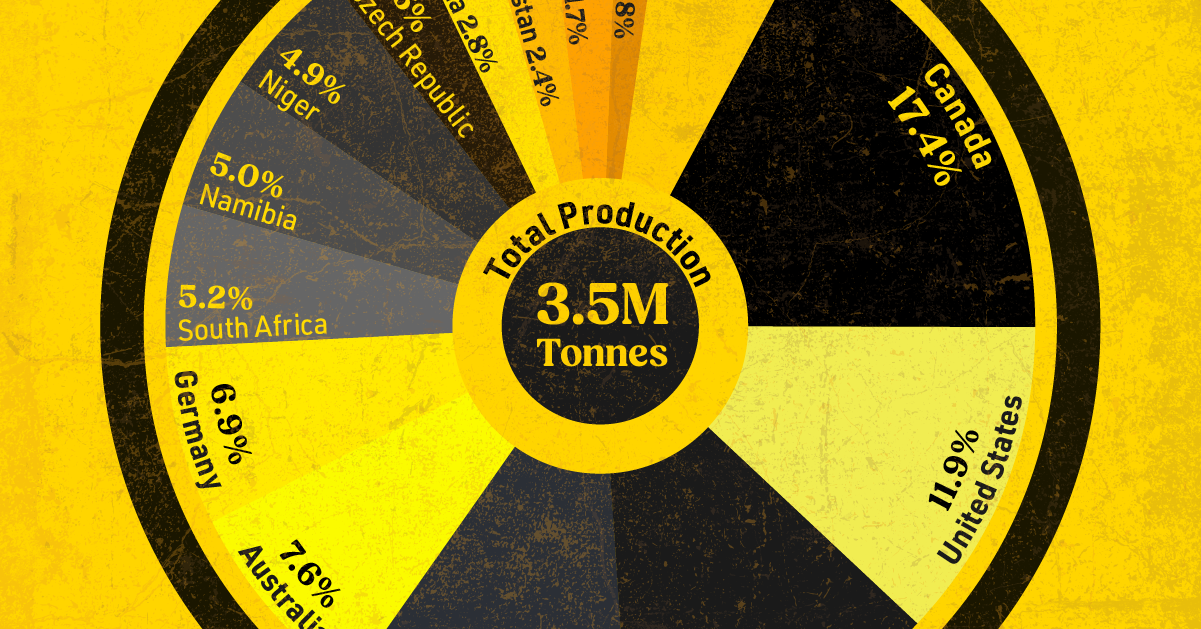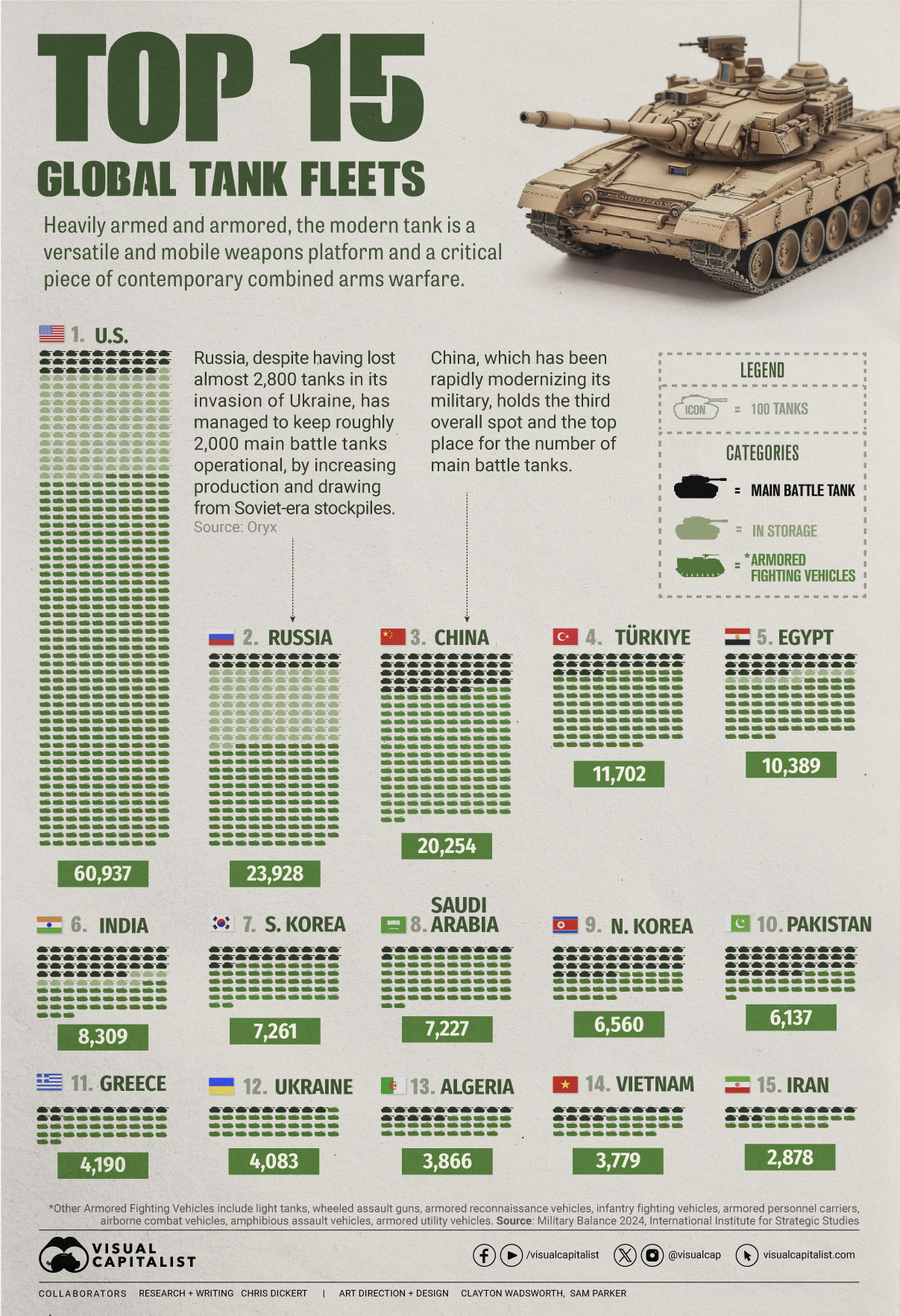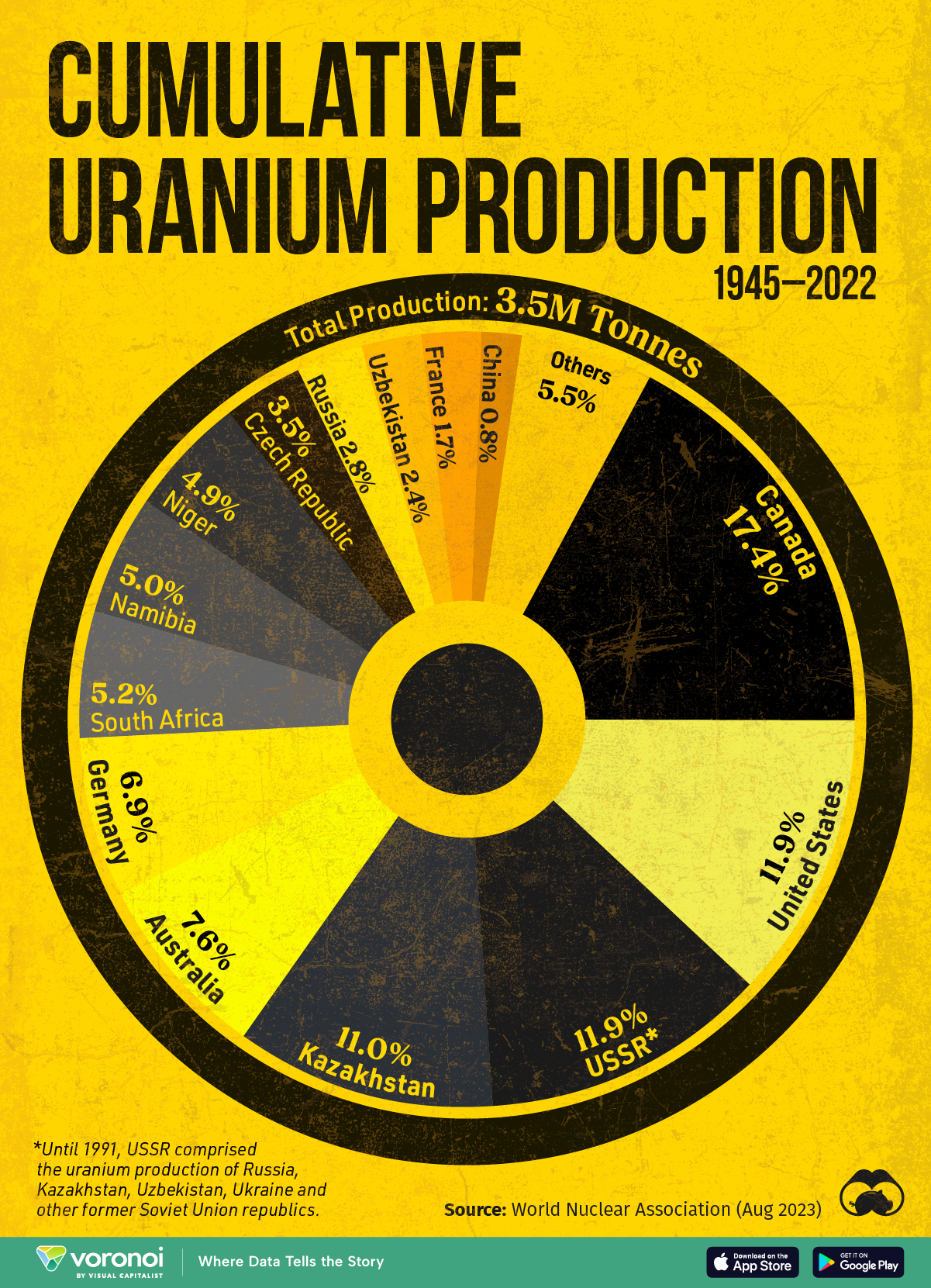War
Visualized: Top 15 Global Tank Fleets
![]() See this visualization first on the Voronoi app.
See this visualization first on the Voronoi app.
The Top 15 Global Tank Fleets
This was originally posted on our Voronoi app. Download the app for free on iOS or Android and discover incredible data-driven charts from a variety of trusted sources.
Heavily armed and armored, the modern tank is a versatile and mobile weapons platform, and a critical piece of contemporary warfare.
This visualization shows the top 15 global tank fleets, using data from the 2024 Military Balance report from the International Institute for Strategic Studies (IISS).
Let’s take an in-depth look at the top three fleets:
1. United States
As the world’s pre-eminent military power, it’s perhaps no surprise that the United States also has the largest tank fleet, by a wide margin.
In total, they have just over 45,000 armored fighting vehicles in operation, along with 2,640 main battle tanks (MBTs), and 12,800 vehicles in storage, of which 2,000 are main battle tanks.
| Category | Vehicles | Global rank |
|---|---|---|
| Main battle tanks | 2,640 | 4 |
| Armored reconnaissance | 1,745 | 1 |
| Infantry fighting vehicles | 3,262 | 3 |
| Armored personnel carriers | 10,644 | 1 |
| Amphibious assault vehicles | 1,401 | 1 |
| Armored utility vehicles | 28,445 | 1 |
| Storage | 12,800 | 1 |
| Total | 60,937 | 1 |
The U.S. is internalizing the lessons from the ongoing invasion of Ukraine, where Western-supplied anti-tank weapons and massed Ukrainian artillery have been cutting Russian tanks to pieces. As a result, the U.S. recently canceled an upgrade of the M1 Abrams in favor of a more ambitious upgrade.
Meanwhile, the U.S. is nervously eyeing a more confident China and a potential clash over Taiwan, where air and naval forces will be critical. However, a recent war game showed that Taiwanese mechanized ground forces, kitted out with American-made tanks and armored fighting vehicles, were critical in keeping the island autonomous.
2. Russia
According to Oryx, a Dutch open-source intelligence defense website, at time of writing, Russia has lost almost 2,800 main battle tanks since invading Ukraine. Considering that in the 2022 edition of the Military Balance, Russia was estimated to have 2,927 MBTs in operation, those are some hefty losses.
Russia has been able to maintain about 2,000 MBTs in the field, in part, by increasing domestic production. Many defense plants have been taken over by state-owned Rostec and now operate around the clock. Russia is also now spending a full third of their budget on defense, equivalent to about 7.5% of GDP.
At the same time, they’ve also been drawing down their Soviet-era stockpiles, which are modernized before being sent to the front. Just how long they can keep this up is an open question; their stockpiles are large, but not limitless. Here is what their storage levels look like:
| Category | 2023 | 2024 | YOY change |
|---|---|---|---|
| Main battle tanks | 5,000 | 4,000 | -20.0% |
| Armored reconnaissance | 1,000 | 100 | -90.0% |
| Infantry fighting vehicles | 4,000 | 2,800 | -30.0% |
| Armored personnel carriers | 6,000 | 2,300 | -61.7% |
| Total | 16,000 | 9,200 | -42.5% |
3. China
China holds the third overall spot and top place globally for the number of main battle tanks in operation. Untypically, the People’s Liberation Army has no armored vehicles in storage, which perhaps isn’t surprising when you consider that China has been rapidly modernizing its military and that stockpiles usually contain older models.
China also has one of the world’s largest fleets of armored fighting vehicles, second only to the United States. Breaking down that headline number, we can also see that they have the largest number of light tanks, wheeled guns, and infantry fighting vehicles.
| Category | Vehicles | Global rank |
|---|---|---|
| Main battle tanks | 4,700 | 1 |
| Light tanks | 1,330 | 1 |
| Wheeled guns | 1,250 | 1 |
| Infantry fighting vehicles | 8,200 | 1 |
| Armored personnel carriers | 3,604 | 5 |
| Airborne combat vehicles | 180 | 2 |
| Amphibious assault vehicles | 990 | 2 |
| Total | 20,254 | 3 |
This is equipment that would be integral if China were to make an attempt to reunify Taiwan with the mainland by force, where lightly armored mechanized units need to move with speed to occupy the island before Western allies can enter the fray. It’s worth noting that China also has one of the world’s largest fleets of amphibious assault vehicles.
End of the Tank?
Many commentators at the outset of Russia’s invasion of Ukraine, were quick to predict the end of the tank, however, to paraphrase Mark Twain, reports of the tank’s demise are greatly exaggerated.
With the U.S. and China both developing remote and autonomous armored vehicles, tanks could be quite different in the future, but there is nothing else that matches them for firepower, mobility, and survivability on the modern battlefield today.
Energy
Cumulative Uranium Production, by Country (1945-2022)
Uranium production is concentrated in a few countries worldwide. This graphic shows the top producers globally since 1945.

Uranium Production, by Country (1945-2022)
This was originally posted on our Voronoi app. Download the app for free on iOS or Android and discover incredible data-driven charts from a variety of trusted sources.
Uranium production in Cigar Lake, Canada is the highest-grade in the world.
Since 2014, the site has mined 105 million pounds of the radioactive metal, which is naturally occurring on Earth. It is the largest uranium mine on the planet. For context, an egg-sized amount of uranium fuel can generate as much electric power as 88 tonnes of coal.
Given its vast uranium deposits, Canada has produced the most uranium worldwide since 1945.
This graphic shows cumulative uranium production by country in modern history, with data from the World Nuclear Association.
The Top Uranium-Producing Countries
Since 1945, a total of 3.5 million tonnes of uranium has been produced globally.
Together, Canada and the U.S. account for over 29% of global production, mining 932,000 tonnes over the last several decades.
| Country | Share of Production | Cumulative Production 1945-2022 (Tonnes) |
|---|---|---|
| 🇨🇦 Canada | 17.4% | 554,475 |
| 🇺🇸 United States | 11.9% | 378,038 |
| ☭ USSR* | 11.9% | 377,613 |
| 🇰🇿 Kazakhstan | 11.0% | 349,789 |
| 🇦🇺 Australia | 7.6% | 240,579 |
| 🇩🇪 Germany | 6.9% | 219,685 |
| 🇿🇦 South Africa | 5.2% | 165,692 |
| 🇳🇦 Namibia | 5.0% | 158,856 |
| 🇳🇪 Niger | 4.9% | 156,797 |
| 🇨🇿 Czech Republic | 3.5% | 112,055 |
| 🇷🇺 Russia | 2.8% | 90,725 |
| 🇺🇿 Uzbekistan | 2.4% | 76,808 |
| 🇫🇷 France | 2.4% | 76,021 |
| 🇨🇳 China | 1.7% | 53,712 |
| 🇺🇦 Ukraine | 0.8% | 24,670 |
| 🌍 Others | 4.7% | 149,299 |
*Until 1991, USSR comprised the uranium production of Russia, Kazakhstan, Uzbekistan, Ukraine and other former Soviet Union republics.
During the Cold War, the USSR mined over 377,000 tonnes of uranium for a variety of purposes including nuclear reactors and naval fuel.
Due to demand from nuclear reactors, uranium production sharply increased from the 1960s to the 1980s. With this came the construction of the earliest generation of nuclear plants. Today, about 436 nuclear reactors are in operation.
Since the war in Ukraine, uranium has drawn increased attention given its role in nuclear weapons. Ukraine had 15 nuclear reactors depending on uranium from Russia, but the country rapidly signed a deal with Canada due to their exposure to the crisis.
Similar to Ukraine, nuclear reactors in Finland were at risk since their Russian-made reactors relied on the know-how of Russian firms.
While uranium is used for defense purposes, it also plays a key role in electricity generation thanks to its low carbon footprint. In the U.S., about 19% of electricity is powered from nuclear plants, and around 10% of global electricity is from nuclear power sources.
-

 Education1 week ago
Education1 week agoHow Hard Is It to Get Into an Ivy League School?
-

 Technology2 weeks ago
Technology2 weeks agoRanked: Semiconductor Companies by Industry Revenue Share
-

 Markets2 weeks ago
Markets2 weeks agoRanked: The World’s Top Flight Routes, by Revenue
-

 Demographics2 weeks ago
Demographics2 weeks agoPopulation Projections: The World’s 6 Largest Countries in 2075
-

 Markets2 weeks ago
Markets2 weeks agoThe Top 10 States by Real GDP Growth in 2023
-

 Demographics2 weeks ago
Demographics2 weeks agoThe Smallest Gender Wage Gaps in OECD Countries
-

 Economy2 weeks ago
Economy2 weeks agoWhere U.S. Inflation Hit the Hardest in March 2024
-

 Green2 weeks ago
Green2 weeks agoTop Countries By Forest Growth Since 2001













